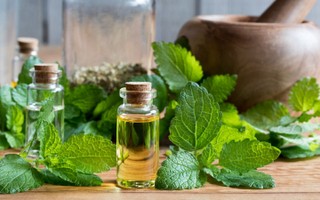13 most aromatic herbs to grow

Herb gardens – both indoor and outdoor – are rapidly gaining popularity with both novice and experienced gardeners. Many people choose to grow herbs as indoor container plants or outside in their garden to give them fresh culinary herbs to use in recipes. But the truth is, growing aromatic herbs has many benefits beyond their use in the kitchen.
Fragrant herbs can attract bees and other pollinators to the garden when grown outside and repel nuisance insect pests helping neighboring plants in both instances. Their aromas can also relax you by creating a calming effect, or they can invigorate your mood just by their scent.
What makes herbs so aromatic?
Some plants are naturally more aromatic than others, but why does that happen? Aromatic plants contain natural chemical components known as essential oils{: target="_blank" rel=“noopener”}, which are responsible for their noticeable scents. These highly volatile compounds are found in the leaves and sometimes stems and are released when the leaves are disturbed or chewed.
 {: width=“1440” height=“1000”}Lavendar is widely regarded as one of the best smelling herbs to grow.
{: width=“1440” height=“1000”}Lavendar is widely regarded as one of the best smelling herbs to grow.

The enthusiast's guide to herbs
We’re proud to present our new e-book, The Enthusiast’s Guide to Herbs! Learn everything you need to know about growing and caring for herbs indoors, including in-depth info cards for the 35 most commonly grown herbs.
Click the link below to find out more!
The 13 most aromatic herbs
If you’re looking for the most aromatic plants to grow in your herb garden, you can’t go wrong with any of the following. Since many plants need to be disturbed or the leaves crushed to release their scent, it’s great to plant herbs next to gates or along walkways where you will brush against them.
Lemon balm (Melissa officinalis)
With a delicious lemony taste, the lemon balm plant leaves are used for both culinary and medicinal purposes. Use it in place of lemon peel to flavor sauces and vinegars, or add it to your homemade pesto for a bright, citrusy flavor.
Lemon balm loves a home on a sunny windowsill in your kitchen, where it can get at least 6 hours of direct sunlight every day. The pot can be moved outside to enjoy the beautiful weather during the summer months in warmer climates. When the leaves are rustled, they release their aroma, which acts as a natural mood booster.
Mint (Mentha spp.)
One of the most common herbs grown, mint{: target="_blank" rel=“noopener”} plants, come in many different types that vary slightly in their characteristics, including flavor. There are about two dozen species and over seven thousand varieties, but the two main types that are grown are peppermint and spearmint. All types have broad leaves in green shades that release a distinctive, albeit minutely different, menthol-based scent when bruised or crushed.
Mint can be a nuisance plant in your aromatic garden, taking over any free space it can infringe, which is why it’s a great herb to grow indoors as a container plant. The container forces it to stay in its area and keeps its growth in check.
Lavender (Lavandula spp.)
One of the quintessential herbs and known for its revered scent, lavender{: target="_blank" rel=“noopener”} is grown as a small, perennial shrub in most parts of the United States. There are five main types of lavender grown: English, French, Spanish, Portuguese, and Lavandin, a hybrid. It can be challenging to grow, though, as it prefers hot, arid conditions. This means it is very temperamental when given too much water or grown in high humidity.
When growing your own lavender, it almost appreciates being neglected to a certain degree. Allow the top one or two inches of soil to dry out before watering, and go easy on the fertilizer.
 {: width=“1440” height=“1000”}Chamomile is known for its benefits as a tea but it also has a pleasant fragrance.
{: width=“1440” height=“1000”}Chamomile is known for its benefits as a tea but it also has a pleasant fragrance.
Chamomile (Matricaria chamomilla)
Growing chamomile indoors not only extends your outdoor growing season, providing you with fresh herbs all year round, but the beautiful white blossoms bring a touch of spring into your home. Chamomile grows very quickly, filling containers with full blooms in about ten weeks.
Keep the potting soil moist at all times, and place pots where the plant receives full sun during the day. They aren’t picky about the types of containers as long as they have adequate drainage in the bottom. It is crucial to make sure the pots are heavy enough they won’t tip over when plants start growing tall.
Rosemary (Salvia rosmarinus)
Rosemary is typically grown outdoors as a highly aromatic evergreen shrub but can be grown as a container plant indoors if given enough light. Ensure plants receive 6 to 8 hours of direct sun daily, and be careful not to overwater them, causing root rot. For the hardiest plants, choose standard green rosemary over the decorative, variegated varieties.
When rosemary sprigs are harvested, its strong flavoring pairs well in meat dishes such as lamb, pork, and veal. The flat, needle-like leaves dry down incredibly well, so you can store the herb for later use.
Basil (Ocimum basilicum)
Known for its essential role in Italian cuisine, basil{: target="_blank" rel=“noopener”} is the key ingredient in pesto, and it is also paired often with tomatoes and used in a wide array of pasta dishes. Basil plants enjoy the conditions of summertime – hot with full sun. Put plants in a sunny windowsill or a garden spot where they received a minimum of 6 to 8 hours of direct sun daily. In the fall, when day lengths shorten, growth decreases, so it may be helpful to supplement plants with a grow light throughout the winter.
Basil is very sensitive to cold temperatures, so it’s essential to keep plants away from draft windows in the winter or air conditioning vents in the summertime.
Pineapple sage (Salvia elegans)
While all sage plants are known for their aroma – which reminds many of elaborate home-cooked Thanksgiving dinners – pineapple sage adds a unique, exciting scent to your herb garden. The fresh leaves are used in summertime beverages or fruit salads.
Pineapple sage plants bloom in the late fall, displaying scarlet-red, tubular flowers revered by hummingbirds. Compared to many of the other 700 cultivars of sage, the foliage on pineapple sage is lighter in color, closer to a yellow-green or greenish-yellow instead of the darker green. This adds excellent contrast when grown next to vibrantly green herbs.
Bay laurel (Laurus nobilis)
Grown as an evergreen tree or shrub, bay laurel’s leaves are typically used to season many slow-cooked dishes like casseroles and stews. Shrubs are hardy and incredibly easy to grow, requiring little care. Growing them in containers outdoors restricts their overall size, keeping them smaller and more manageable.
Bay laurel grows well in containers – whether indoors or outside – as the containers restrict their overall growing habit, keeping plants shorter and more manageable. When grown indoors, regularly prune plants, so they don’t exceed more than 5 or 6 feet in height. Keep plants in a brightly lit spot in your home, so they receive a minimum of six to eight hours of direct sunlight each day.
 {: width=“1440” height=“1000”}Flowering Catnip
{: width=“1440” height=“1000”}Flowering Catnip
Catnip (Nepeta cataria)
Also known as catmint, catnip is a hardy perennial herb belonging to the mint family. It can be used by both cats and humans, giving you plenty of reasons to add this plant to your list of fragrant herbs to grow. There are many reasons to add catnip plants to your indoor herb garden with uses for both cats and humans.
Catnip contains the essential oil nepetalactone{: target="_blank" rel=“noopener”}, which mimics a specific feline pheromone, triggering brain receptors and the associated euphoric side effects. If catnip is consumed, it acts as a sedative for your cat; if sniffed, it acts as a stimulant. In humans, it doesn’t induce the same euphoric responses but has many medicinal uses.
Thyme (Thymus vulgaris)
One of the popular culinary herbs, thyme bears heady aromatic leaves on a low-growing evergreen plant. The flavor varies slightly depending upon the specific variety grown; thyme is usually used to season soups, stews, and meat dishes.
When grown in a container, plant thyme in a clay pot to let the soil dry out between waterings; it hates having soggy roots, preferring the soil to be a touch on the dry side. Regularly pinch the tops off your plants and prune back woody stems to encourage fuller, bushy plants full of new growth. When grown outside, it makes an excellent ground cover.
Marjoram (Origanum majorana)
Native to the Mediterranean, marjoram{: target="_blank" rel=“noopener”} is well suited for growing indoors in containers since this tender perennial loves warm, sunny, arid climates. Plants spread like ground covers, so they grow best in wide, shallow containers with plenty of room for the trailing stems.
Marjoram is drought resistant, so allow the potting soil to dry out before watering your plant. Too much water causes root rot and encourages both insect pests and disease problems. When plants are six inches tall, begin harvesting from the plant’s tips to keep it bushy and full.
Oregano (Origanum vulgare)
Oregano seasons many Mexican and Mediterranean and dishes and is gaining popularity in indoor herb gardens. Plants are perennial, coming back year after year when grown outside. Indoors they prefer light, well-drained soils and little to no fertilizer. Allow the soil to dry out between watering. When grown outdoors, it acts as a perennial plant, coming back every spring.
The more you harvest oregano, the fuller the plant will be, continuing to put out new growth. The subtly flavored purple to white flowers should be removed from the plants as soon as they appear – instead of throwing them away, use them as a topping for salads.
Anise hyssop (Agastache foeniculum)
With a flavor comparable to anise, the herb anise hyssop is confusing as it is neither anise seed nor hyssop, and it isn’t even a blend of the two. A member of the mint family, it adds a mild, minty, licorice flavor to vegetable dishes and salads. The seeds are used as a substitute for anise when baking; the leaves are used either fresh or dried to make herbal tea.
Anise hyssop grows well as a companion plant with most other herbs. Impressive spikes of lavender-colored blooms add a beautiful touch to your herb garden, whether indoors or out.

Join our email club—get printable info cards free!
Sign up to receive our newsletter and get access to 10 printable plant info cards from our e-book for free. Also receive:
- $4 discount code for our Guide to Herbs e-book
- Semi-weekly plant inspiration & bite-size tips and tricks
